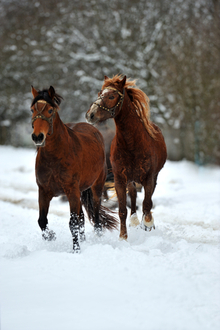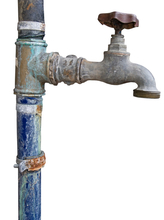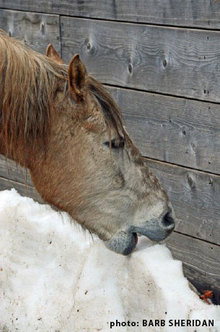Most horse owners know that colic is the number one noninfectious health risk for horses, and veterinarians warn that decreased water consumption is thought to be the primary predisposing factor for compaction colic, especially when horses decrease the amount they are drinking either because water is too cold to be palatable or a good source of water is not available because of freezing temperatures.
Impaction colic is essentially constipation and most often includes the accumulation of hard, dry fecal material in the colon. The usual signs of impending impaction colic are depression, a decreased appetite and decreased production and dryness of manure.

Cold weather - Cold water - A threat to horse health
Most horse owners know that colic is the number one noninfectious health risk for horses, and veterinarians warn that decreased water consumption is thought to be the primary predisposing factor for compaction colic.
Although poor hay quality, lack of exercise, internal parasites and dental problems are all predisposing factors for impaction colic, decreased water consumption is thought to be the primary predisposing factor for the condition, especially in the winter when most horses drink less water.
In general, horses will often reduce their water intake as temperatures fall. The combination of reduced water intake, with increased forage consumption during the cooler months makes them more susceptible to health issues. Relying on a horse to eat only snow as the source of water does not provide them with the daily intake that they need in order to survive. Remember, water is the most important nutrient that your horse requires daily, all year round.
Horse's drinking habits studied
In the mid-90âs, researchers at the University of Pennsylvania School of Veterinary Medicine conducted a series of studies to determine whether horses would drink more water during cold weather if it was heated.
In the first study, researchers provided one group of horses with water that was near freezing (32-38 degrees Fahrenheit) and the other group with water that was heated (66 degrees Fahrenheit).
In horses, whether or not they were stalled, 82 percent of the drinks took place within three hours after feeding. So, if we are using buckets that need to be refilled, itâs important that we refill them at or just after feeding twice a day.
What they found was that during cold weather, horses drank 40 percent more water when the water was heated. But only if that was the only source of water available.
If there was icy water available, they drank almost exclusively from the icy water and drank less volume than if they had only warm water available. So the important conclusion is that your horses will drink more water during cold weather if it is heated but no other source of water should be available.
In the study, the researchers also observed some interesting aspects of horse drinking behavior. For example, horses in the stalls that are fed hay and grain will do most of their drinking within a few minutes after eating the grain and within an hour or so after they are given hay, regardless of water temperature.
They also noted that in all horses, whether or not they were stalled, 82 percent of the drinks took place within three hours after feeding. So, if we are using buckets that need to be refilled, itâs important that we refill them at or just after feeding twice a day. Remember, that the average 1,200 âpound horse will drink seven to 10 gallons of water a day, so a five-gallon bucket of water twice a day is adequate in most cases unless the horse is exercising and sweating heavily.
The study demonstrated there was no difference in water consumption between heated water buckets filled twice daily and water continuously available in a heated stock tank.
Maintaining your horse's water supply in cold weather
If you live in an area where freezing temperatures threaten your horse's water supply, insulate water hydrants and exposed pipes. Insulating tape can be purchased at most local hardware stores and is an inexpensive way to avoid frozen water supplies. Tank heaters for outdoor water troughs are also available at local farm supply stores. Purchase a heater designed for livestock tanks. Some heaters are only designed to bring water to a boil.

Protect your horse barn pipes
How many of us have experienced broken pipes in the winter. Simple preparations save you time and money.
Use a unit specifically made for the size and shape of the tank in the pasture. An improperly fitting heater rests against tank walls and could melt a hole through the side or bottom of the tank. Check the water level daily to ensure the heater is submerged and working properly.
Basketballs or soccer balls left floating on the water's surface can be enough to keep water from freezing in regions that do not experience hard freezes.
Consider investing in a generator. In the event of a power outage, barns relying on wells will not have water. Depending on the distance between the barn and the next available water supply it could be too far to transport water daily.
Know how to turn off the water supply to the barn. In the event that a pipe bursts, it is important to know how to shut off the main flow of water to avoid flooding.
In their fall bulletin, Equine Guelph has important tips for horse owners about getting ready for approaching winter weather. Your paddock preparation should include readying your water system to ensure a supply of fresh, clean, unfrozen water for your horse during the cold winter months.

Eating snow - Not an adequate water supply for horses
Horses will often reduce their water intake as temperatures fall and the combination of reduced water intake with increased forage consumption during the cooler months makes them more susceptible to health issues.
© 2015 by Barbara Sheridan
A number of different options are available to help horse owners manage water supplies for their horses over the winter months. Depending on your facility setup there are outdoor and indoor water solutions, including de-icers, drinking posts, automatic waters, and heated buckets as examples.
If you are looking for a long-term solution, installing heated automatic waters is a safe bet. They are more money up front, but it pays off in the long term with labor efficiency and overall reliability that provides peace of mind for the horse owner. They come in different sizes and have heating elements that keep the water in the bowl from freezing.
The nice aspect about going with an automatic waterer with a built-in water heater is that you donât have to manually fill the tanks each day. Though, it is still important to check the watering system daily to ensure that they are working properly.
A popular option is installing a frost-free yard hydrant. They operate all year round, including the winter. One of the main features of a hydrant is a stop-and-drain valve. When the valve is open, water comes from the line. And when the valve is closed, the flow of the water stops. The water left in the pipe flows out of the drain hole and into the gravel bed.
The catch with this option is that you will still need to manually get the water for your horse at least twice a day by hand from the hydrant. If you are using the hydrant to fill a stock tank you will need to use a tank de-icer to keep the water from freezing once it is in the tank. You can also use a heated hose to get the water from the hydrant to the trough.
If you donât have access to electricity, it will be harder to keep the water from freezing, but it can be done. One of the best options out there is a drinking post. Case in point, it is low maintenance, electricity-free, and is an all season waterer that operates much like a frost-free hydrant.
Did you know?
Horses can and will consume some snow through the winter, but six to ten times as much snow must be eaten to provide an equal amount of water, and the calories used to melt the snow should be used for body warmth, condition, maintenance and overall health.
The drinking post is installed below the frost line. As the horse presses on the paddle, the bowl fills up with water. Once drinking is complete, the water drains so it does not freeze.
If your horse is accustomed to a bucket in its stall, you can go with a heated bucket. They come in different sizes, but often the larger the better (16 gallon). As a safety feature, they come with grounded cords, located at the back of the buckets. This is important if your horse decides to chew the bucket. Heated buckets are to be used in an indoor sheltered facility.
Your horseâs hydration and health rely on consistent access and consumption of water and maintaining a comfortable drinking temperature encouraging them to drink. To avoid hauling water by hand in the snow, winterize your facility in advance which will save you some barn chore hassles during the winter months.
If you already have winter water options, consider upgrading them or at least conduct an annual inspection to make sure your watering systems are in good working order. This includes checking for leaks, major rust spots, and making sure all elements are working correctly. Once your systems are installed and in use, be sure to check them on a daily basis to make sure the water supply is free flowing.
Consider this
The bottom line is to increase water consumption and decrease the likelihood of impaction colic by providing warm water in the winter and preventing access to cold water. If you have any questions about preventing colic in your horse, your local veterinarian is always your best source of information.
